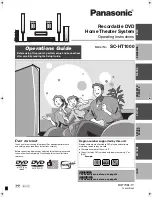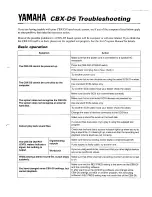
Si37-701
Symptom-based Troubleshooting
Troubleshooting
213
Symptom
Supposed Cause
Countermeasure
7
The system
conducts fan
operation but not
cooling or
heating
operation.
This symptom occurs
immediately after turning ON
the power supply.
The system is in preparation
mode of operation.
Wait for a period of approximately
10 minutes.
8
The airflow rate
is not
reproduced
according to the
setting.
Even pressing the AIRFLOW
RATE SET button makes no
changes in the airflow rate.
In heating operation, when the
room temperature reaches the set
degree, the outdoor unit will stop
while the indoor unit is brought to
fan LL operation so that no one
gets cold air.
Furthermore, if fan operation
mode is selected when other
indoor unit is in heating operation,
the system will be brought to fan
LL operation.
(The fan LL operation is also
enabled while in oil return mode in
cooling operation.)
Normal operation.
9
The airflow
direction is not
reproduced
according to the
setting.
The airflow direction is not
corresponding to that
displayed on the remote
controller.
The flap does not swing.
Automatic control
Normal operation.
10 A white mist
comes out from
the system.
<Indoor unit>
In cooling operation, the
ambient humidity is high.
(This indoor unit is installed in
a place with much oil or dust.)
Uneven temperature distribution
due to heavy stain of the inside of
the indoor unit
Clean the inside of the indoor unit.
<Indoor unit>
Immediately after cooling
operation stopping, the
ambient temperature and
humidity are low.
Hot gas (refrigerant) flown in the
indoor unit results to be vapor
from the unit.
Normal operation.
<Indoor and outdoor units>
After the completion of
defrosting operation, the
system is switched to heating
operation.
Defrosted moisture turns to be
vapor and comes out from the
units.
Normal operation.
11 The system
produces
sounds.
<Indoor unit>
Immediately after turning ON
the power supply, indoor unit
produces "ringing" sounds.
These are operating sounds of
the electronic expansion valve of
the indoor unit.
Normal operation.
This sound becomes low after a
lapse of approximately one
minute.
<Indoor and outdoor units>
"Hissing" sounds are
continuously produced while in
cooling or defrosting operation.
These sounds are produced from
gas (refrigerant) flowing
respectively through the indoor
and outdoor units.
Normal operation.
<Indoor and outdoor units>
"Hissing" sounds are produced
immediately after the startup or
stop of the system, or the
startup or stop of defrosting
operation.
These sounds are produced
when the gas (refrigerant) stops
or changes flowing.
Normal operation.
<Indoor unit>
Faint sounds are continuously
produced while in cooling
operation or after stopping the
operation.
These sounds are produced from
the drain discharge device in
operation.
Normal operation.
<Indoor unit>
"Creaking" sounds are
produced while in heating
operation or after stopping the
operation.
These sounds are produced from
resin parts expanding and
contracting with temperature
changes.
Normal operation.
<Indoor unit>
Sounds like "trickling" or the
like are produced from indoor
units in the stopped state.
On VRV systems, these sounds
are produced when other indoor
units in operation. The reason is
that the system runs in order to
prevent oil or refrigerant from
dwelling.
Normal operation.
<Outdoor unit>
Pitch of operating sounds
changes.
The reason is that the compressor
changes the operating frequency.
Normal operation.
Summary of Contents for VRV III REYQ8PY1
Page 1: ...REYQ8 48PY1 R 410A Heat Recovery 50Hz Si37 701...
Page 59: ...Specifications Si37 701 48 Specifications...
Page 105: ...Refrigerant Flow for Each Operation Mode Si37 701 94 Refrigerant Circuit...
Page 230: ...Si37 701 Troubleshooting by Remote Controller Troubleshooting 219...
Page 374: ...Si37 701 Piping Diagrams Appendix 363 REYQ14P 16PY1 3D058153A S2NPL S1NPH...
Page 375: ...Piping Diagrams Si37 701 364 Appendix REMQ8PY1 3D057743...
Page 376: ...Si37 701 Piping Diagrams Appendix 365 REMQ10PY1 12PY1 3D057742...
Page 377: ...Piping Diagrams Si37 701 366 Appendix REMQ14PY1 16PY1 3D057741...
Page 382: ...Si37 701 Piping Diagrams Appendix 371 1 3 BS Unit 4D057985A...
Page 384: ...Si37 701 Wiring Diagrams for Reference Appendix 373 REYQ14 16PY1 3D056774C...
Page 385: ...Wiring Diagrams for Reference Si37 701 374 Appendix REMQ8PY1 3D055307E...
Page 386: ...Si37 701 Wiring Diagrams for Reference Appendix 375 REMQ10 12PY1 3D055308E...
Page 387: ...Wiring Diagrams for Reference Si37 701 376 Appendix REMQ14P 16PY1 3D055309E...
Page 392: ...Si37 701 Wiring Diagrams for Reference Appendix 381 FXCQ40M 50M 80M 125MVE 3D039557A...
Page 394: ...Si37 701 Wiring Diagrams for Reference Appendix 383 FXZQ20M 25M 32M 40M 50M8V1B 3D038359...
Page 395: ...Wiring Diagrams for Reference Si37 701 384 Appendix FXKQ25MA 32MA 40MA 63MAVE 3D039564C...
Page 399: ...Wiring Diagrams for Reference Si37 701 388 Appendix FXDYQ180M 200M 250MV1...
Page 402: ...Si37 701 Wiring Diagrams for Reference Appendix 391 FXMQ200MA 250MAVE 3D039621B...
Page 403: ...Wiring Diagrams for Reference Si37 701 392 Appendix FXHQ32MA 63MA 100MAVE 3D039801D...
Page 406: ...Si37 701 Wiring Diagrams for Reference Appendix 395 2 4 BS Unit 3D055928C...
Page 423: ...Piping Installation Point Si37 701 412 Appendix...
Page 427: ...Example of Connection R 410A Type Si37 701 416 Appendix...
Page 433: ...Method of Checking the Inverter s Power Transistors and Diode Modules Si37 701 422 Appendix...
Page 447: ...Si37 701 iv Index...
Page 451: ...Si37 701 viii Drawings Flow Charts...
















































